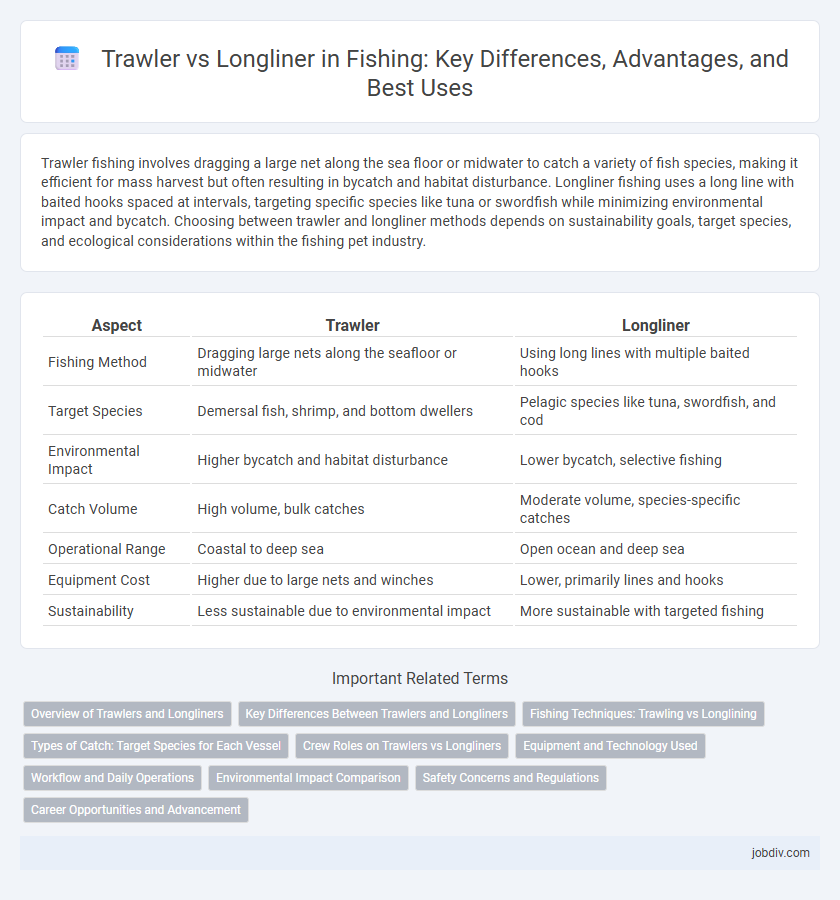Trawler fishing involves dragging a large net along the sea floor or midwater to catch a variety of fish species, making it efficient for mass harvest but often resulting in bycatch and habitat disturbance. Longliner fishing uses a long line with baited hooks spaced at intervals, targeting specific species like tuna or swordfish while minimizing environmental impact and bycatch. Choosing between trawler and longliner methods depends on sustainability goals, target species, and ecological considerations within the fishing pet industry.
Table of Comparison
| Aspect | Trawler | Longliner |
|---|---|---|
| Fishing Method | Dragging large nets along the seafloor or midwater | Using long lines with multiple baited hooks |
| Target Species | Demersal fish, shrimp, and bottom dwellers | Pelagic species like tuna, swordfish, and cod |
| Environmental Impact | Higher bycatch and habitat disturbance | Lower bycatch, selective fishing |
| Catch Volume | High volume, bulk catches | Moderate volume, species-specific catches |
| Operational Range | Coastal to deep sea | Open ocean and deep sea |
| Equipment Cost | Higher due to large nets and winches | Lower, primarily lines and hooks |
| Sustainability | Less sustainable due to environmental impact | More sustainable with targeted fishing |
Overview of Trawlers and Longliners
Trawlers use large nets dragged along the sea floor or midwater to catch multiple fish species in bulk, making them highly efficient for commercial fishing. Longliners deploy extensive lines with thousands of baited hooks, targeting specific species like tuna and swordfish with minimal bycatch. Both methods offer distinct advantages, with trawlers excelling in volume and longliners in selectivity and sustainability.
Key Differences Between Trawlers and Longliners
Trawlers use large nets dragged along the sea floor or midwater to catch a variety of fish species in bulk, while longliners deploy thousands of baited hooks on a single long line targeting specific species like tuna and swordfish. Trawling often results in higher bycatch and habitat disturbance compared to longlining, which is more selective but slower. Energy consumption is typically greater in trawling due to continuous net dragging, whereas longlining requires less fuel but demands more time for setting and hauling lines.
Fishing Techniques: Trawling vs Longlining
Trawling involves dragging a large net through the water or along the sea floor to capture schools of fish, making it highly efficient for catching species like cod and haddock. Longlining uses a mainline with baited hooks spaced at intervals, targeting specific fish such as tuna and swordfish while minimizing bycatch. Both techniques vary in environmental impact and catch selectivity, influencing sustainable fishing practices.
Types of Catch: Target Species for Each Vessel
Trawlers primarily target bottom-dwelling species such as cod, haddock, and shrimp, using large nets dragged along the seabed to capture demersal fish and crustaceans. Longliners specialize in pelagic and migratory species like tuna, swordfish, and halibut, deploying thousands of baited hooks on long lines to selectively catch these high-value fish. Each vessel type employs distinct fishing methods optimized for different habitats and target species, influencing catch composition and bycatch rates.
Crew Roles on Trawlers vs Longliners
Crew roles on trawlers typically include deckhands responsible for handling heavy nets and winches, a skipper managing navigation and operations, and engineers maintaining the vessel's machinery. In contrast, longliners require crew specialized in baiting hooks and setting long fishing lines, with roles divided between line handlers, skippers, and deck supervisors to coordinate the precise deployment and retrieval of gear. The complexity of equipment on trawlers demands intensive mechanical skills, while longliner crews emphasize expertise in line management and fish species identification.
Equipment and Technology Used
Trawlers utilize large, heavy nets dragged along the seafloor or midwater, equipped with powerful winches, sonar systems, and GPS technology to optimize fish detection and catch efficiency. Longliners deploy extensive lines with thousands of baited hooks, often outfitted with sophisticated electronic devices such as GPS, radio communication, and hook sensors to monitor gear and improve catch rates. Advanced technologies in both methods enhance sustainability by allowing precise targeting and minimizing bycatch, with trawlers relying on sonar imaging and longliners leveraging automated baiting and retrieval systems.
Workflow and Daily Operations
Trawlers operate by dragging large nets along the seabed or midwater to catch schools of fish, requiring substantial crew coordination for setting, monitoring, and hauling heavy gear multiple times daily. Longliners deploy thousands of baited hooks on a single line, which demands precise handling and frequent checks to optimize catch rates while minimizing bycatch throughout the fishing cycle. Both methods involve distinct workflows where trawling emphasizes continuous mechanical operations and longlining relies on strategic bait placement and hook management.
Environmental Impact Comparison
Trawlers drag heavy nets across the seabed, causing significant habitat destruction and high bycatch rates, which threaten marine biodiversity. Longliners set baited hooks on lines that minimize seabed damage and reduce bycatch, making them more sustainable for targeted species like tuna and swordfish. Choosing longlining over trawling helps preserve marine ecosystems by maintaining habitat integrity and lowering unintended species capture.
Safety Concerns and Regulations
Trawlers face higher safety risks due to heavy equipment and rough seas, leading to stricter regulations on vessel stability and crew training by authorities like the International Maritime Organization (IMO). Longliners benefit from fewer onboard hazards but must comply with strict rules on bait handling and bycatch mitigation to reduce environmental impact and maintain crew safety. Both fishing methods require adherence to safety protocols such as Emergency Position-Indicating Radio Beacons (EPIRBs) and regular inspections to minimize accidents and ensure regulatory compliance.
Career Opportunities and Advancement
Career opportunities in trawler fishing often involve roles such as deckhands, engineers, and captains, with advancement typically based on experience and certifications in vessel operation and maintenance. Longliner fishing careers provide specialized positions including baiters, hook setters, and safety officers, with progression linked to expertise in gear handling and sustainable fishing practices. Both sectors offer potential growth through training in navigation technology and fisheries management, enhancing job security and leadership prospects.
Trawler vs Longliner Infographic

 jobdiv.com
jobdiv.com